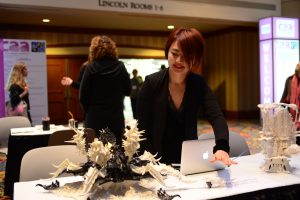CAA News Today
Participate in ARTexchange at the 2017 Annual Conference
posted by CAA — September 08, 2016
 The artist Young Suk Lee participates in ARTexchange at the 2016 Annual Conference in Washington, DC (photograph by Bradley Marks)
The artist Young Suk Lee participates in ARTexchange at the 2016 Annual Conference in Washington, DC (photograph by Bradley Marks)The Services to Artists Committee invites artist members to participate in ARTexchange, CAA’s unique pop-up exhibition and annual meet-up for artists and curators. This social event provides an opportunity for artists to share their work and build affinities with other artists, historians, curators, and cultural producers. ARTexchange will take place at the 105th Annual Conference in New York on Friday evening, February 17, 2017, from 5:30 to 7:30 PM.
Each artist is given the space on, above, and beneath a six-foot table to exhibit their work: prints, paintings, drawings, photographs, sculptures, and small installations; performance, process-based, interactive, and participatory works are especially encouraged. Previous ARTexchange participants have found that this parameter sparked many creative display options. Please note that artwork cannot be hung on walls, and it is not possible to run power cords from laptops or other electronic devices to outlets.
To participate as an exhibiting artist in 2017, contact Katie Apsey, CAA manager of programs, by December 2, 2016, with the following information: (1) a short description of what you will exhibit and how you will use the six-foot table space (provide details regarding performance, sound, spoken word, or technology-based work, including laptop presentations); (2) your CAA member number (memberships must be active through February 18, 2017); and (3) your website or a link to a digital portfolio.
Because ARTexchange is a popular venue and participation is based on available space, early applicants are given preference. Participants are responsible for their work; CAA is not liable for losses or damages. Sales of work are not permitted. Deadline extended: January 6, 2017.
CAA Membership Benefits
posted by CAA — September 07, 2016
 As a member of CAA, you already know you can get a discount to our Annual Conference – taking place in New York, February 15-18, 2017 – receive subscriptions to CAA publications like The Art Bulletin and Art Journal, access to our online career center, and also receive benefits through our member partners to everything from discounts on web development services, print subscriptions rates, health insurance and car rentals, to exclusive member-only access to art fair previews and events.
As a member of CAA, you already know you can get a discount to our Annual Conference – taking place in New York, February 15-18, 2017 – receive subscriptions to CAA publications like The Art Bulletin and Art Journal, access to our online career center, and also receive benefits through our member partners to everything from discounts on web development services, print subscriptions rates, health insurance and car rentals, to exclusive member-only access to art fair previews and events.
In addition to connecting you to a vital network of professionals in the visual arts, we want your CAA membership benefits to match your needs.
What new membership benefits or partners would you like to see develop?
Please email Vivian Woo, CAA Marketing and Development Manager vwoo@collegeart.org by September 30th and tell us what membership benefits would be meaningful to you. Contact us today!
News from the Art and Academic Worlds
posted by Christopher Howard — September 07, 2016
Each week CAA News summarizes eight articles, published around the web, that CAA members may find interesting and useful in their professional and creative lives.
Know Your Rights: A Tool for Artists
Creative Capital spoke with Joy Garnett from the Arts Advocacy Project at the National Coalition against Censorship about a new educational tool, Artist Rights, which was created to address questions that artists may have about their rights under the First Amendment. (Read more from Creative Capital.)
Is Getting an MFA Worth the Price?
In the 2000s, the MFA was pitched as a Golden Ticket, with an ever more youth-oriented art market generating rumors of dealers snapping up artists right out of school. A degree that was originally designed to allow you to teach became seen as the pathway to a gallery career. In more recent years, angst about art school has become entangled with the political debate about student debt’s crushing toll. (Read more from Artnet News.)
Notes for a New Faculty Member
When I first started teaching more than twenty years ago, I was a TA, nervous, excited, and preoccupied by technical details that suddenly seemed important. There were assignments to draft, grading techniques to practice, readings to master, departmental policies to incorporate into syllabi, and training sessions to attend. It was easy, in those overwhelming days, to forget why I wanted to be in the classroom to begin with. (Read more from the Chronicle of Higher Education.)
How Men Benefit from Family-Friendly Tenure Policies
Academics are well aware that gender gaps continue to exist on American campuses. It is true that female students now outnumber male students, and also that more women earn professional degrees compared to men. But it is also true that only 28 percent of tenured faculty are women. (Read more from the Conversation.)
Fair Use and the Future of Art
Twenty-five years ago, in a seminal article in the Harvard Law Review, Judge Pierre Leval changed the course of copyright jurisprudence by introducing the concept of “transformativeness” into fair-use law. Soon thereafter, the Supreme Court embraced Leval’s new creation, calling the transformative inquiry the “heart of the fair use” doctrine. Yet the transformative test has failed art, and this article shows why and what to do about it. (Read more from the New York University Law Review.)
Organizations with Staying Power
As we strive to ensure that our arts organizations have a sustainable future, management teams across the UK are focusing on income and diversifying business models as key drivers for resilience. Resilience is the buzzword at the moment and was the subject of a session at the Arts Fundraising Summer School at the University of Leeds. (Read more from Art Professional.)
A Brief Guide to the Battle over Trigger Warnings
The University of Chicago’s dean of students recently sent a strongly worded letter to incoming freshmen declaring that the institution didn’t endorse “trigger warnings” or “intellectual safe spaces.” The message touched off a debate both inside and outside academe about the use of such terms on college campuses. Here’s a look at how professors view the warnings—and at how widespread they really are. (Read more from the Chronicle of Higher Education.)
How Trigger Warnings Silence Religious Students
Last week, the University of Chicago’s dean of students sent a welcome letter to freshmen decrying trigger warnings and safe spaces—ways for students to be warned about and opt out of exposure to potentially challenging material. While some supported the school’s actions, arguing that these practices threaten free speech and the purpose of higher education, the note also led to widespread outrage. (Read more from the Atlantic.)
New in caa.reviews
posted by CAA — September 02, 2016
Mickey Abel and Karlyn Griffith discuss The Crusader Bible: A Gothic Masterpiece at the Blanton Museum of Art. Devoted to a single manuscript, the exhibition “represents an extraordinary opportunity to see a significant treasure of the Middle Ages.” Through “historical didactics, innovative technology, and the spatial layout,” the curator demonstrates the “contemporary relevancy of cross-cultural exchange.” Read the full review at caa.reviews.
David B. Brownlee reviews Michael Hall’s George Frederick Bodley and the Later Gothic Revival in Britain and America, an “enormous and enormously rich biography of one of the greatest High Victorians.” Although the immense volume “slightly exasperates even an avid reader,” “it is worth persisting” to read this “compelling account of his multifaceted and path-breaking creativity.” Read the full review at caa.reviews.
Robert E. Harrist Jr. reviews The Efficacious Landscape: On the Authorities of Painting at the Northern Song Court by Foong Ping. “Brimming with new findings,” the book provides “original interpretations of the role ink landscape painting played at the Northern Song imperial court” and “the most extensive account in a Western language” of the artist Guo Xi’s career. Read the full review at caa.reviews.
Caa.reviews publishes over 150 reviews each year. Founded in 1998, the site publishes timely scholarly and critical reviews of studies and projects in all areas and periods of art history, visual studies, and the fine arts, providing peer review for the disciplines served by the College Art Association. Publications and projects reviewed include books, articles, exhibitions, conferences, digital scholarship, and other works as appropriate. Read more reviews at caa.reviews.


